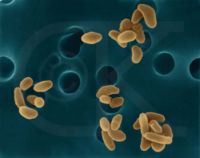Francisella tularensis: Difference between revisions
No edit summary |
|||
| Line 31: | Line 31: | ||
==Description and significance== | ==Description and significance== | ||
Francisella tularensis is a highly contagious bacteria that causes "rabbit fever" | |||
==Genome structure== | ==Genome structure== | ||
Revision as of 07:06, 3 May 2007
Classification
Higher order taxa
Domain: Bacteria
Phylum: Proteobacteria
Class: Gamma Proteo Bacteria
Order: Thiotrichales
Family: Francisellaceae
Genus
Genus species: Francisella tularensis
|
NCBI: Taxonomy |
Edited by Neena Patel, student of Rachel Larsen at UCSD.
Description and significance
Francisella tularensis is a highly contagious bacteria that causes "rabbit fever"
Genome structure
Describe the size and content of the genome. How many chromosomes? Circular or linear? Other interesting features? What is known about its sequence? Does it have any plasmids? Are they important to the organism's lifestyle?
Determination of the DNA genome sequence of this strain has been or is being determined either in whole or in part.
Treponema denticola ATCC 35405 has a complete genome. It is made up of dsDNA and 1 chromosome. It is circular and the length is 2,843,201 nucleotides. The GC content is 37%. It has 2838 genes. Replicon Type: chromosome.
Cell structure and metabolism
Describe any interesting features and/or cell structures; how it gains energy; what important molecules it produces.
Ecology
Describe any interactions with other organisms (included eukaryotes), contributions to the environment, effect on environment, etc.
Francisella tularensis infects small mammals such as rabbit and rodents with the disease tularemia. Francisella tularensis can also infect human through contact with infected animals or vectors such as fleas and mosquitos. It can also be spread to humans by being in their water or food supply.
Pathology
Treponema denticola is a bacterial pathogen and plant plastid. It causes periodontal disease and gum inflammation.
How does this organism cause disease? Human, animal, plant hosts? Virulence factors, as well as patient symptoms.
Application to Biotechnology
Francisella tularensis was researched and used as a biological weapon during World War II and two decades afterwards. During World War II, Japan conducted research on the bacteria for its potential as a biological weapon. Francisella tularensis has the potential to be a biological weapon because it is very infectious (a small number, about 10-50 organisms, can cause disease). As a biological weapon it is most effective when spread airbrone, and the United States developed weapons that can deliver aerosol Francisella tularensis in the 1950s-60s. The Soviet Union, along with using Francisella tularensis as a weapon, also developed antibiotic and vaccine resistant strains against the bacteria.
The effects of the biological weapon are severe respiratory illness including pneumonia and systemic infection that if not treated, can result in death.
Current Research
Enter summaries of the most recent research here--at least three required
References
http://www.cdc.gov/ncidod/dvbid/tularemia.htm
example:
Edited by student of Rachel Larsen and Kit Pogliano

